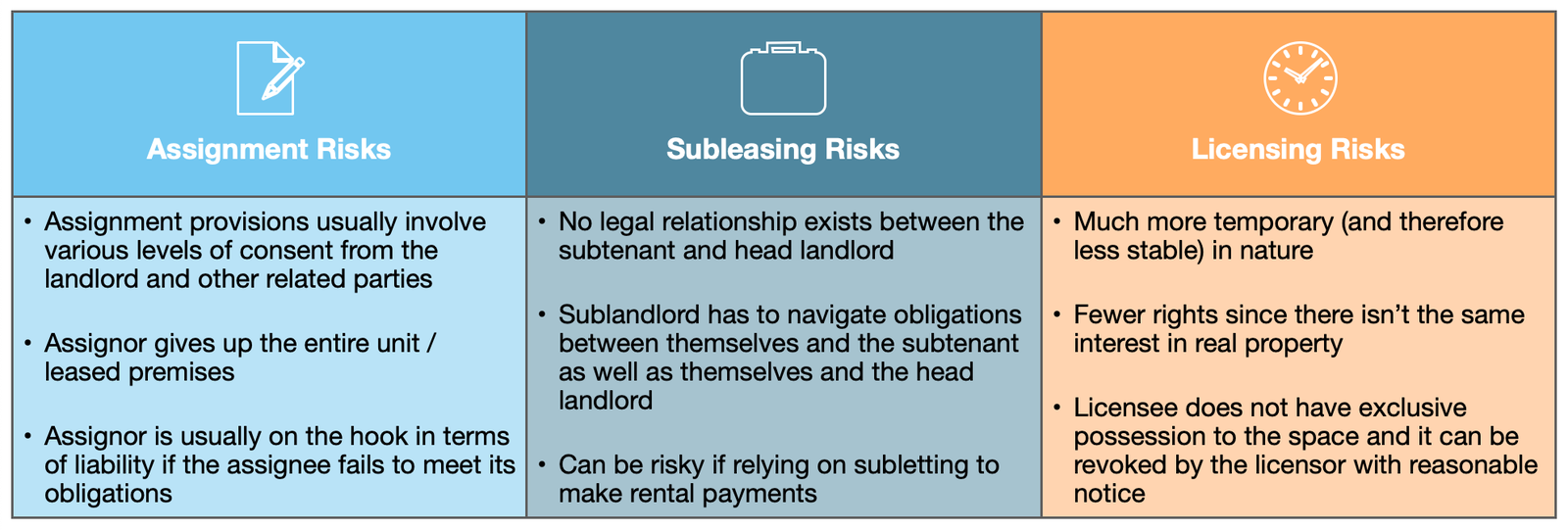

What is Assignment of Lease and How It Differs from Subletting
The assignment of lease (and rent) is a foggy topic that is often confused with subletting. Let's clear the air once and all right now. Learn the differences between a lease assignment and sublease so you can make the right choice.
What is Assignment of Lease? - The Important Basics
Let's begin by introducing the 3 players in a lease assignment - The landlord, the original tenant (assignor) and the new tenant (assignee). The original tenant has an unexpired lease agreement with the landlord and he wants out. Since the original tenant can't just break the agreement and walk off, what he does is to get a new tenant to swap places... and take over all his rights and obligations for the remainder of the lease period. So if the original tenant signs a 1 year commercial lease and the business goes bust after 8 months, the new tenant will be assigned a 4-month commercial lease (with the same terms and conditions as the original agreement). Now here's the big catch: Even though the original tenant has handed over all his duties and obligations to the new tenant, he is not off the hook... unless the landlord agrees to release him from all liabilities. If the new tenant stirs up trouble, our dear original tenant will find himself in hot soup as well. Of course, whether the original tenant is allowed to pull this assignment trick out of his hat is a whole new matter. Knowing for sure is actually simpler than most people think: First, examine your local landlord tenant laws for any lease assignment rules. Most of the time, landlords are given the right to allow or disallow assignments but once in a while, the local law let tenants have the final say instead. If there's no mention of lease assignments in your law text, then your rental lease agreement shall dictate the terms.
Difference Between Lease Assignment and Subletting
When it comes to subletting vs assignment of lease, there's often a massive mix-up. Sometimes even real estate professional get it wrong by assuming them to be one and same thing. However if you dig deeper, you will find that the differences are not just numerous, but important as well. Let's begin by dragging the landlord into the picture. An assignment of lease launches the new tenant into a direct relationship with the landlord - The landlord collects rent straight from the new tenant and deals with the new tenant directly on all lease issues. So in this case, the original tenant gets to take back seat and doesn't have to manage the new tenant actively. On the other hand, there's no direct relationship between the landlord and new tenant (subtenant) in a sublease. Instead the original tenant plays mother goose and is responsible for collecting rent from the subtenant and making sure that he's following the lease rules. When you compare the two, a sublease is a lot more hands-on for the original tenant. No matter which path you take, you will still want a good new tenant who pays the rent on time and follows the lease rules to the agreement. For the golden rules on screening tenants and running credit checks, Click here for our guide to running tenant credit checks. When you have a lease assignment, the terms and conditions of the lease remains largely unchanged - It's almost like taking the original lease agreement and swapping the tenant's name with another. With a sublease, there's more breathing space - The original tenant can decide how much rent to charge, how long the subtenant is going to stay or even collect security deposit... as long as it stays within the boundaries drawn by the original lease agreement between the landlord and original tenant.
Should You Choose Assignment of Lease or Sublease?
You are the Landlord - A lease assignment is recommended in most cases. You will have more control over your new tenant (instead of leaving matters in the original tenant's hands and hoping that he would do a good job)... plus you still have the original tenant to cover your back in case anything goes wrong. You are the Original Tenant - Now this is a tricky one. If you want to someone to take over the entire lease and property for its remaining duration (e.g. your business goes belly-up and you no longer need the office), then help yourself to a lease assignment. If the landlord's consent is required for assignment (and he doesn't give the nod), you can always try offering him a lease assignment fee as a deal sweetener. However, if you are looking for someone to share the place (and rent)... or perhaps you need someone to cover the rent while you are overseas for a few short months, then a sublease would be ideal. You are the New Tenant - An assignment of lease works better for you most of the time. You won't be at the mercy of the original tenant (for example if he screws up and the landlord terminates the original lease agreement, your sublease might also go up in flames). But if you only want to rent part of the property... or don't want to tie yourself down for the remaining lease duration, then you are better off sticking to a sublease. Now that we have covered the topic of assignment vs sublease, go ahead and take your pick - Click here for an assignment of lease form or Click here for a sublet agreement instead.
Landlord Tenant Law
- 3 Methods of Resolving Landlord Tenant Disputes
- Federal Fair Housing Act - Avoiding Discrimination
- Security Deposit Laws for All U.S. States
- U.S. State Laws on the Return of Security Deposit
- Sublet Laws - Subletting Laws for All U.S States
- Assignment of Lease and How it Differs from Subletting
- Guide to Commercial Landlord Tenant Law
- How to Find a Good Real Estate Lawyer
- What to Look for When Hiring a Real Estate Attorney
Becoming a Landlord
- Buying Rental Property
- Financing Properties
- First Time Landlord
- Property Manager Career
- Managing Tenants
- Tenant Screening
- Tenant Credit Check
- Rent Payment
- Security Deposit
- Property Maintenance
Landlord Tenant Rights
- Types of Tenancy
- Breaking a Lease
- Section 8 Landlord
Accounting & Taxes
- Landlord Insurance
- Landlord Accounting
- Rental Property Tax
- Landlord Resources
- Landlord Software
- Landlord Tenant Forms

Privacy Policy
© 2008- Propertydo.com. All Rights Reserved.
.
Assigning vs. Subletting A Commercial Lease

Most commercial lease arrangements allow tenants to rent-out their usable space to a third-party renter. Although this can be a cost-effective way to maximize commercial space, tenants must be careful: when a tenant decides to rent part or all of their commercial space to a third-party, they are fully responsible for the actions or inactions of the new renter.
When it comes to commercial real estate, a legally-binding agreement is often signed between a landlord and a tenant. But when the tenant decides to sublet or assign their lease to a third-party, they become the sublessor, while the new third-party renter becomes the sublessee. Sometimes, the sublessor and sublessee are referred to the primary and secondary tenant respectively.
In any case, there’s only one legally liable party in the sublessor-sublessee relationship: the sublessor. In other words, should the sublessee damage the property or fall-behind on payments, compensating the landlord is the primary tenant’s legal obligation. Nonetheless, choosing a trustworthy and reliable third-party renter often results in a winning situation for both parties.
Get a Lawyer to Review Your Lease
Can I Rent Out my Commercial Unit?
In most instances, tenants are indeed allowed to rent their commercial space to third-party renters. However, this is usually up to the discretion of the landlord. Likewise, subletting must be done in-compliance with local state- and municipal-laws.
Before making any commitments to potential renters, tenants should ensure they are legally allowed to rent their usable space. This determination often depends on three factors:
- State- and Municipal-Regulations
- The Original Commercial Lease Agreement
- Landlord Consent
First—and perhaps foremost—tenants should review their local housing regulations. Some areas require a landlord’s written-consent before tenants can sublet or assign their lease. Even when states don’t make landlord-consent a prerequisite, landlords themselves often write provisions into the original lease that ensures permission is granted before subletting. Thus, you’ll need to revisit the terms and conditions of your original commercial lease agreement.
The original lease should contain specific language about subletting, however these provisions are oftentimes absent. If subletting provisions are indeed missing, you’ll need to speak to the landlord directly. So long as the landlord’s permission is granted and the arrangements are compliant with local laws, tenants are allowed to rent-out their unit to whom every they wish. Primary tenants that meet these requirements typically have two options: they can 1) sublet their commercial lease, or 2) assign their commercial lease.
Subletting vs. Assigning the Lease
Subletting and assigning are two different ways to structure the relationship between a primary and secondary tenant. Although the structures are similar, they have important practical differences.
- Lease-Assignment: the complete transfer of rental rights from a primary tenant to a third-party renter (importantly, the primary tenant is still responsible for the terms of the original lease)
- Subletting: the partial transfer of rental rights from a primary tenant to a third-party renter, usually for a temporary period of time or for only a portion of the usable space
When a tenant assigns their lease to a third-party renter, they are offering the entirety of their usable space without the intention of returning. This is unlike a conventional sublease structure, which offers only part of the unit and usually for a temporary period of time.
Why would a business owner want to assign their commercial lease? Importantly, a tenant is legally obligated to carry-out the terms of their commercial lease agreement, regardless of the circumstances. Lease-assignment is practical when original tenants cannot—for whatever reason—uphold their end of the lease. For example, if a business owner signs a 3-year commercial lease, but goes out of business 2-years into the agreement, they’ll likely seek somebody to complete the final 12-months of the term.
On the other hand, if a primary tenant is only interested in splitting their usable space or looking for a temporary third-party renter, subletting is the more practical option.
Who is the Responsible Party?
The commercial lease between the landlord and tenant is a legally-binding document. Regardless of the tenant’s situation, they are required by-law to carry-out the terms and conditions of the contract. Even when a lease is assigned to a third-party renter, the primary tenant is still responsible for the rental obligations.
Perhaps unsurprisingly, the same rules apply to subletting. When a tenant sublets their usable space, they remain the sole responsible party; should the third-party renter fail to make payments or cause damage to the rental unit, the original tenant is responsible.
Verbal or written agreements between tenants and third-party renters are great for establishing rules and responsibilities, but are more-so personal arrangements and not legally enforceable. For this reason, it’s imperative that choosing a third-party renter is given ample consideration—regardless if you’re assigning your lease or simply looking to sublet. It’s not unfair to request bank statements, criminal histories, or credit reports before making a commitment to a secondary tenant.
In some situations, landlords will in-fact release the original tenant from liability when the lease is assigned to a third-party renter, rendering the new renter responsible for the terms of the original lease. This is sometimes called “permeant assignment” and is definitely worth exploring when considering lease-assignment. Usually this stipulation is negotiated between the landlord and tenant; an experienced legal professional may be helpful in these situations.
Related Articles

- Why We're Different
- Our Legal Team
- Sell Your Practice
- Legal Dictionary
This website is lawyer advertising and no attorney-client relationship or obligation arises from your use of this site, by submitting information through the site, or by calling our office.
Interested in more referrals? Check out the first referral platform for independent business attorneys.
© 2024 BizCounsel, Inc.
- Terms of Use
- Privacy Policy

- Advanced Search
- Search by Map
- Property Tracker
- Luxury Homes
- TREG's Open Houses
- Hampton Roads
- All Communities
- Isle of Wight
- Newport News
- Virginia Beach
- Williamsburg Area
- Williamsburg
- Charles City County
- Gloucester County
- James City County
- King William County
- New Kent County
- York County
- North Carolina
- Camden County
- Chowan County
- Currituck County
- Elizabeth City
- Gates County
- Outer Banks
- All New Homes
- Virginia New Homes
- North Carolina New Homes
- Property Management Services
- TREG's Featured Rentals
- Resident Portal
- Owner Portal
- Our Offices
- Meet Our Agents
- Careers in Real Estate
- TREG Employment Opportunities
- MIlitary Relocation
- Corporate Relocation
- Worldwide Relocation
- Atlantic Bay Mortgage Group
- Landmark Title
- 2-10 Home Buyers Warranty
- Old Republic Home Protection
We're Here to Help
Have a question or want a free market report.

- TREG Property Management
Assignment vs Subletting - What is the difference?
Assignment vs subletting – what are the differences.

Assigning a residential lease agreement and subletting are two distinct ways of transferring tenancy rights in a rental property, each involving different legal and practical implications. Here’s a breakdown of their differences:
Assignment of a Residential Lease Agreement:
Definition:
Transfer of Responsibility: Assigning a lease involves transfer of the original tenant’s entire interest in the lease to a new tenant. The original tenant ceases to have any rights or obligations related to the property.
Consent from Landlord: Typically requires the landlord's explicit permission or consent. The landlord is often involved in vetting and approving the new tenant.
Replacement Tenant: The original tenant may find a replacement (assignee) who takes over the lease entirely. The landlord may also market for a new tenant and vet any potential replacement tenants.
Legal Responsibility:
Liability: The assignor (original tenant) is usually released from all liabilities and obligations once the lease is assigned to the new tenant. This may key off of the new tenant taking possession of the rental unit.
Direct Relationship with Landlord: The new tenant (assignee) becomes directly responsible to the landlord for rent payments, property maintenance, and adherence to lease terms by effectively “stepping into the shoes” of the departing tenant.
Implications:
End of Original Tenancy: For the assignor, once the lease is assigned, their association with the property generally ends. They may not have recourse if the assignee defaults on payments or breaches the lease.
Subletting of a Residential Lease Agreement:
Partial Transfer: Subletting occurs when the original tenant rents out all or part of the property to a subtenant while retaining some rights and responsibilities under the original lease.
Consent from Landlord: Usually requires the landlord's permission, as outlined in the lease agreement. Some leases explicitly prohibit subletting.
Ongoing Relationship with Landlord: The original tenant (sublessor) maintains responsibility to the landlord for lease obligations.
Obligations: The sublessor remains responsible for rent payments and adherence to lease terms, acting as an intermediary between the landlord and subtenant.
Relationship with Subtenant: The sublessee has a legal relationship with the sublessor rather than the landlord. The sublessee must adhere to terms agreed upon in the sublease.
Ongoing Responsibility: The original tenant (sublessor) remains liable to the landlord for the property and its condition. They're responsible for any damages or lease violations caused by the sublessee.
Continued Tenancy: The original tenant maintains an ongoing relationship with the property and the landlord.
How Much Would Your Home Rent For?
Key Differences:
- Transfer of Responsibility: Assigning a lease completely transfers the tenant's interest to a new tenant, while subletting involves the original tenant retaining some rights and responsibilities.
- Direct Relationship : In assignment, the new tenant has a direct relationship with the landlord, whereas in subletting, the original tenant maintains this relationship.
- Liability and Obligations: Assigning a lease typically releases the original tenant from obligations, while subletting keeps them responsible for the property.
Both assignment and subletting can offer flexibility to tenants but come with distinct legal and practical implications that tenants and landlords should carefully consider before proceeding. Understanding these differences helps individuals choose the appropriate option based on their circumstances and lease agreement terms.
In most cases, assignment is the best course as it avoids the main pitfall of subletting, namely that the subletting tenant has no direct relationship or responsibility to the landlord/owner of the rental unit. For that reason, professional property managers normally recommend termination of the original lease and negotiation of a new lease with the replacement tenant. The outgoing tenant will normally absorb some of the costs associated with securing a replacement and the property manager makes sure the turnover is handled property. Having experience when these issues arise is important to protect the landlord’s interests. If you need management of an investment property, call one of our managers today to learn why so many landlords believe TREG is the RIGHT CHOICE for property management.
Post a Comment
Related posts.

Mold Prevention in Rental Properties
The importance of preventing mold in rental properties cannot be overstated. Mold not only poses potential health risks but ...

Understanding Tenant Bankruptcy
Relationships between landlords and tenants occasionally take unexpected turns. Tenants who were perfectly qualified when ...
Posts By Category
Posts by month, search our agent directory.
- Hampton Roads Real Estate
- Chesapeake Real Estate
- Hampton Real Estate
- Isle of Wight Real Estate
- Norfolk Real Estate
- Portsmouth Real Estate
- Suffolk Real Estate
- Virginia Beach Real Estate


New Home Communities
Hampton Roads Complete New Construction Resource.

- Bertie Real Estate
- Camden County Real Estate
- Chowan County Real Estate
- Currituck County Real Estate
- Edenton Real Estate
- Elizabeth City Real Estate
- Gates County Real Estate
- Hertford Real Estate
- Pasquotank County Real Estate
- Perquimans County Real Estate

Luxury Homes & Lifestyles
Oceanfront & Bayfront. Country Clubs. Equestrian / Horse Farms. Luxury Condos. See them all.
- Chesapeake Townhouses for Sale
- Hampton Townhouses for Sale
- Virginia Beach Townhouses for Sale
- Chesapeake VA Condominiums
- Hampton VA Condominiums
- Norfolk VA Condominiums
- Suffolk VA Condominiums
- Virginia Beach Condominiums
- Birdneck Point
- Broad Bay Colony
- Heron Ridge Estates
- Linkhorn Cove
- Linkhorn Estates
- Point Chesapeake on the Bay
- Trant Berkshire
- Witchduck Point
- Avon NC Real Estate
- Buxton NC Real Estate
- Duck NC Real Estate
- Frisco NC Real Estate
- Hatteras NC Real Estate
- Kill Devil Hills NC Real Estate
- Kitty Hawk NC Real Estate
- Manteo NC Real Estate
- Nags Head NC Real Estate
- Rodanthe NC Real Estate
- Salvo NC Real Estate
- Southern Shores NC Real Estate
- Wanchese NC Real Estate
- Waves NC Real Estate

Find out why so many landlords and seasoned investors think TREG is the RIGHT CHOICE for property management.
- Chesapeake Property Management
- Norfolk Property Management
- Portsmouth Property Management
- Suffolk Property Management
- Virginia Beach Property Management
The Real Estate Group Customer Reviews


Commercial Real Estate Subleasing for Beginners: Assignments, sublets, and licensing — what’s the difference?
by admin | Jan 21, 2022 | Blog | 0 comments

Please click here to read Part 1: https://realstrategy.com/commercial-real-estate-subleasing-for-beginners/
Assignments
When a tenant decides to assign a lease, they are essentially giving up the space and all their rights and responsibilities to the rental agreement to a third-party assignee. In these cases, the assignee will usually work directly with the landlord and will take on all the obligations under the original lease basically becoming the new tenant. The old tenant is not involved anymore except that they’re often required to maintain some sort of liability if the assignee fails to meet the terms of the lease or defaults.
Subleasing, on the other hand, is when a subtenant takes over a piece of or the entire space and the original tenant then plays the role of the sublandlord. The sublandlord and landlord maintain a relationship in this context because the original tenant still has to adhere to the obligations of the headlease (i.e. the primary lease).
The sublandlord also has obligations to the subtenant under the sublease. The major point to note here is that the sublease has to be for a shorter term than the headlease. It’s a very specific legal point that can make a really big difference but if the sublease term extends past the headlease’s, it can actually be deemed an assignment.
Licensing, while separate, is related to subletting in that it still involves the occupation of space, but licenses are not leases. With leasing, tenants have the right to exclusive possession of the premises, whereas licensing is a separate form of property interest where the right to non-exclusive use of space is merely granted.
A common example of this practice is the vendor carts and stations in malls. These vendors don’t have the exclusive right to that space in the middle of the walkway and are simply licensing it. Since there is not a lease or exclusive possession, licensees have fewer rights associated with the space.
“It’s a very good idea for tenants, in particular, to seek legal counsel because the differences between these situations can have huge impacts on their responsibilities and liabilities.” — Vanessa Carment (Associate Lawyer, Soloway Wright LLP)

Negotiating subleases and provisions in the current climate
Since more organizations are interested in subleasing, one of the main areas to be concerned with is indemnity and mutual releases between relevant parties. In other words, you’ll want your subleasing provisions to account for cases where the subtenant does something that messes up the property or removes chattels and fixtures for example. Make sure to have clear obligations and requirements for the subtenant in this case so that you (as sublandlord) are not left responsible to the head landlord and that the subtenant is.
Speaking more to the recent situation of the pandemic, people are really looking at force majeure. Force majeure was considered a boilerplate clause for the longest time that wasn’t acted on very often. It sets out certain situations that may impede a party’s ability to meet their obligations under the lease and has classically included things like acts of war and strikes. It usually excludes payment of rent but sometimes it doesn’t. Nowadays, everybody is including phrases such as pandemics, epidemics, public health emergencies, government orders, and any sort of language that’s adjacent to what’s been experienced with COVID-19.
“The thing to consider with force majeure is that the specific language is extremely important. If you say pandemic and the situation that arises isn’t declared as such, then the court may side with the landlord since it wasn’t technically a pandemic.” — Vanessa Carment (Associate Lawyer, Soloway Wright LLP)
People are now including certain provisions surrounding various emergencies that guarantee specific rights and requests. For example, the landlord might be required to provide a certain amount of health-related measures for the building and occupants, such as sanitizing surfaces more often. Although not a popular practice, you could in theory put in a provision where the subtenant is also entitled to sublease in certain situations. If the original tenant finds themselves in a sublandlord position and is concerned that the subtenant may not be able to meet their financial obligations, they may want to have an out in the form of a sub-sublease.
Really, it all goes back to the negotiating power that exists between the parties and the larger context at hand. With the record vacancy being observed, especially with office buildings, landlords are more receptive to reducing their requirements and broadening their horizons to increase occupancy in their buildings. Likewise, if a tenant is looking for a subtenant in a very competitive market, they may want to reduce the amount of rent payable under the sublease, or offer free rent as an alternative to cash inducements typically used to offset construction costs of the incoming tenant.
Negotiating with flexibility in mind and offering discounts is also a great way to make space enticing for potential tenants. At the end of the day, making some profit or at least breaking even is more attractive than going further into the hole. It’s really about the recovery of your contracted liability, which is a fancy way of saying how much you would continue to pay the landlord if you honoured the terms of your lease. Generally in a sublease, we at Real Strategy Advisors feel that anywhere from 50% – 75% recovery is considered good.
Contact Real Strategy Advisors today so we can discuss your organization’s back-to-work strategy and how to take advantage of this historic market opportunity.
Soloway Wright is a regional law firm with offices in Ottawa and Kingston. The law firm offers a dynamic blend of knowledge and experience to clients requiring assistance with Real Estate, Business, Commercial Litigation and Leasing, Personal Injury, Medical Malpractice, Planning and Land Development, Employment and Labour, and Estate Planning and Administration law matters.
Recent Posts
- Work is Dead; Love, Live ‘Peopling’
- Magnetic Space With Lachlan Henderson of Orangutech
- Commercial Real Estate Spotlight: Kevin Guerette (Administrative & Marketing Coordinator)
- Chuck’s Boat
- The Top 3 Trends of New Offices in Ottawa
- Find a Lawyer
- Ask a Lawyer
- Research the Law
- Law Schools
- Laws & Regs
- Newsletters
- Justia Connect
- Pro Membership
- Basic Membership
- Justia Lawyer Directory
- Platinum Placements
- Gold Placements
- Justia Elevate
- Justia Amplify
- PPC Management
- Google Business Profile
- Social Media
- Justia Onward Blog
Subleases and Assignments by Tenants & Related Legal Concerns
Some landlords allow a tenant to sublet their unit to a third party, while others do not. If you are considering this option, you should check your lease or rental agreement to make sure that it is permitted. Even if it is not explicitly prohibited, you should get your landlord’s permission in advance to minimize future disputes.
How a Sublease Works
A subtenant is not a co-tenant and does not have a direct relationship with your landlord. As their “landlord,” you can (and should) require them to pay rent directly to you and evict them if they fail to follow through. This differs from a co-tenant, who can be evicted only by your landlord. If you decide to evict your subtenant, you will need to follow the same procedures that would be required of a landlord. A month-to-month rental agreement may be better for a subtenant arrangement than a lease. Any agreement should clearly state the amount of the rent, the length of the tenancy, and any security deposit that may be required.
A tenant will usually need their landlord’s permission before subletting their unit, but some state or local laws may prevent landlords from unreasonably denying subleases.
You should be aware that any benefits that you give your subtenant must fit within the overall rules that the landlord imposes for the property and the people who live there. Even though the subtenant did not sign your lease with the landlord, its terms apply to them as well.
You should make sure that you are confident about the subtenant’s financial situation and ability to comply with the terms of the sublease and the landlord’s rules. If they fail to pay rent or damage the property, you will be on the hook to the landlord for all of your own rent and the cost of any repairs. In extreme situations, such as criminal activity by your subtenant, the landlord may evict you in order to remove the subtenant. You also may face an eviction if you get into a dispute with your subtenant. If they refuse to leave when you return, for example, it may be easier for the landlord to simply evict both of you.
Can a Subtenant Turn Into a Tenant?
A subtenant can turn into a tenant if the landlord and you start acting as though the subtenant is a co-tenant. The most common issue here is who receives rent from the subtenant. If they start paying the landlord rather than you, they will have a strong argument that they are the landlord’s tenant. To prevent your subtenant from gaining the rights of a co-tenant, you should make sure that they pay rent to you, and then you can send it to the landlord.
Assigning a Lease
While assignments are often discussed together with subleases, they should not be confused. An assignment transfers the rest of your lease to a new tenant, and it usually happens when you want to move out before the lease is over. While a sublease makes you the landlord of the subtenant, an assignment makes the assignee a tenant of your landlord. All of the terms of your existing agreement with the landlord most likely will apply to the assignee. (There is an exception if the agreement contains a personal term, such as handling errands for the landlord in exchange for reduced rent.) The original tenant, the assignee, and the landlord all will need to sign the assignment document for it to become valid.
The original tenant will remain liable for rent that the assignee does not pay unless the landlord agrees otherwise.
Assignments can be risky because the original tenant remains on the hook to the landlord for all of the remaining rent if the assignee fails to pay it. This essentially makes the original tenant a guarantor for the rent, so it may be more appealing to try to terminate the lease early and let the next tenant start a new lease. Sometimes, however, you can work around this default rule and get the landlord’s consent to take you off the hook for any rent that the assignee does not pay.
Vacation Rentals (Airbnb)
Many tenants try to earn extra money by listing a home as a short-term vacation rental on websites like Airbnb. You should make sure that your lease permits this type of rental, since you may face eviction if you use Airbnb without your landlord’s authorization. You should get any ensuing agreement with your landlord in writing. It should cover issues such as how much of your unit will be leased to the short-term renter, how often you can list on Airbnb, and financial considerations such as any amount of the Airbnb rent that the landlord receives.
In addition to getting your landlord’s permission, you will want to make sure that listing your home for a short-term vacation rental complies with any zoning or land use laws in your area. You must comply with any restrictions in these laws, even if your landlord does not require it.
Finally, you may want to purchase renters’ insurance, while being aware that it may not cover people in a vacation rental. Some insurance companies are extremely reluctant to provide policies to people who plan to list on Airbnb or similar services.
Last reviewed October 2023
Landlord - Tenant Law Center Contents
- Landlord - Tenant Law Center
- Choosing a Place to Rent & Legal and Financial Concerns
- Understanding Leases and Rental Agreements & Their Legal Implications
- Changing a Lease or Rental Agreement
- Rent Rules and the Legal Rights & Obligations of Tenants
- Security Deposit Rules & Tenants' Legal Rights
- Inspecting a Rental Property Before Signing a Lease
- Co-Tenants' Legal Rights & Obligations on a Lease
- Subleases and Assignments by Tenants & Related Legal Concerns
- Major Repairs to Rental Property & Tenants' Legal Options
- Minor Repairs to Rental Property & Tenants' Legal Options
- Improvements, Alterations, and Fixtures on Rental Property
- Tenants' Legal Rights to Privacy
- Injuries to Tenants on Rental Property & Related Legal Claims
- Environmental Hazards on Rental Property & Enforcing Tenants' Legal Rights
- Inadequate Security at Rental Property & Tenants' Legal Options
- Terminating a Lease of Rental Property & Related Legal Rights and Obligations
- Abandoning Personal Property When Leaving a Rental Unit
- Recovering a Security Deposit When Leaving a Rental Unit
- Resolving Disputes With Your Landlord Without a Lawyer
- Responding to Legal Notices Terminating a Tenancy
- The Eviction Legal Process for Tenants
- Working With a Tenants' Rights Lawyer
- Tenants' Legal Rights & Duties — FAQs
- Landlords' Legal Rights & Duties
- Housing Discrimination Law
- Eviction Laws and Forms: 50-State Survey
- Find a Landlord Tenant Lawyer
Related Areas
- Consumer Protection Law Center
- Civil Rights and Discrimination Legal Center
- Foreclosure Law Center
- Animal and Dog Law Center
- Related Areas
- Bankruptcy Lawyers
- Business Lawyers
- Criminal Lawyers
- Employment Lawyers
- Estate Planning Lawyers
- Family Lawyers
- Personal Injury Lawyers
- Estate Planning
- Personal Injury
- Business Formation
- Business Operations
- Intellectual Property
- International Trade
- Real Estate
- Financial Aid
- Course Outlines
- Law Journals
- US Constitution
- Regulations
- Supreme Court
- Circuit Courts
- District Courts
- Dockets & Filings
- State Constitutions
- State Codes
- State Case Law
- Legal Blogs
- Business Forms
- Product Recalls
- Justia Connect Membership
- Justia Premium Placements
- Justia Elevate (SEO, Websites)
- Justia Amplify (PPC, GBP)
- Testimonials
Ryan Rauner's Real Estate Blog
The abcs of cre.

Assignment vs. Subletting: What’s the Difference?
According to the Bureau of Labor Statistics, 20% of small businesses fail in their first year, 30% fail in their second year, 50% fail after five years, and 70% of small business owners fail in their 10th year in business. Yikes! Despite these grim statistics, commercial leases are generally a minimum of 5 years and contain severe, default penalties. In some cases, landlords will require the tenant to personally guarantee the lease, effectively using the tenant’s personal assets, i.e. home, as collateral to secure the lease.
Most tenants understand the implications of defaulting on their lease and enter into the agreement, eyes-open, and with every intention of abiding by the terms and conditions. The road to hell (and default) are paved with good intentions. Economic downturns, lost contracts/clients, sequestration, etc. can disrupt even the best laid plans; leaving tenants struggling or unable to meet their monetary obligations under their lease. In such cases, tenants’ most powerful tool/strategy to avoid default is to sublease or assign their lease.
Most, if not all, commercial leases contain Assignment and Sublease provisions and while the specific language and conditions can vary there are general, shared principles. Subletting and assigning are similar in that they both involve a transfer of the tenant’s right or interest in the lease that allow another (3 rd ) party to occupy the leased premises. Under the terms of most lease agreements the original tenant will remain responsible for the terms of the lease in the case of either a sublease or an assignment. This means that the landlord can proceed against the tenant in the case of a default by the subtenant or assignee; including but not limited to, rental payments, damage to the leased premises, etc. As a result, it is in both the tenant and landlord’s interest to carefully vet the proposed subtenant or assignee.
If subleases and assignments are similar in that they essentially allow the tenant to “rent out” their space to a 3 rd party, what’s the difference ?
Under a sublease, the tenant is either (sub)leasing a portion of the leased premises for the remainder of the lease term, all of the leased premises for a portion of the lease term, or a portion of the leased premises for a portion of the lease term. Subleases do not necessarily indicate financial hardship on behalf of the tenant or a likelihood of default. In fact, in some cases, companies may choose to lease more space than needed upon the lease commencement date in order to reserve the space for future growth. This is more common with large companies, i.e. Google, that can afford the lease payments but may seek to reduce expenses by subleasing the unused space. Another situation in which a tenant may request to sublease their space is in the case of a downsizing, consolidation, etc. where the they no longer need their entire space but do not want to move and can offset their rental obligations by renting the unused portion to another party.
Under a lease assignment, the tenant transfers all of its rights and responsibilities under the lease to the assignee along with its right to occupy the entire leased premises for the remainder of the lease term. A lease assignment is a much more serious request on behalf of the tenant than a request to sublease the space. While not always the case, a request to assign the lease may indicate that the tenant is unable or unwilling to continue to make lease payments and is likely to default on its lease then or at some point in the future. As stated earlier, most leases require the original tenant to remain liable for the lease (payments, responsibilities, etc.); however, with lease assignments the landlord may release the tenant and enter into a direct relationship with the assignee. The landlord’s decision will be based on a number of factors, most notably the financial strength of the assignee and the difference between the contract rent and market rents. Assignments are not necessarily indicative of financial trouble and can simply be the result of tenants relocating or consolidating; resulting in them no longer needing the leased premises.
Share this:
Leave a reply cancel reply, discover more from ryan rauner's real estate blog.
Subscribe now to keep reading and get access to the full archive.
Type your email…
Continue reading

- New Construction + Condos
- Affordable Housing
- Negotiating + Financing
- How to Buy in NYC Guide

- Roommates + Landlords
- How to Rent in NYC Guide

- Staging + Open Houses
- Negotiations + Closings
- Getting Ready
- How to Sell in NYC Guide

- Kids + Pets
- Neighborhood Intel
- Products + Test-drives
- Troubleshooting

- Small Spaces
- Small Projects + DIY
- Renovations
- Design + Architecture
- Products + Services
- How to Renovate in NYC Guide

- Boards & Buildings
- Property Management
- Structure & Systems
- Sustainability

- Advertise with us
- Sponsored Content

Find Your Next Place
What’s the difference between a sublet and an assignment?

With both a sublet and a lease assignment, the departing tenant remains responsible for the rent unless a landlord explicitly releases you.
When Ismail Mustafa, a tenant in Dumbo, wanted to break his lease recently, the landlord gave him three options: He could arrange a sublet, transfer the lease to someone else, or end the lease by paying two months of rent upfront.
There’s obviously a financial cost to paying two months rent as a penalty for breaking your lease but it is also the most clear-cut break with your landlord. If you're considering the same options as Mustafa, it's important to know the difference between transferring your lease to someone else (also known as an assignment) and subletting. Neither are without risk.
"The bottom line is—none of the options is perfect—each has advantages and disadvantages," says attorney Steven Kirkpatrick, a partner at the law firm Romer Debbas.
It's worth pointing out that a fourth option might be offered to you: To move out and pay rent until the landlord finds a tenant. This is highly "problematic," says Catherine Grad, a tenant attorney with her own practice. "You no longer have control over the process and you are still on the hook for the rent and you’ve given the power to someone who’s incentive is less than yours."
Subletting vs. assignment
When you sublet your place it's typically because you intend to return to the apartment. A sublet will usually end a week—but it could be just a day—before the actual end of your original lease.
Subletting for the entire length of the lease is an assignment. An assignment allows you to hand off the rental to a new tenant for the rest of the lease term. This is what Mustafa ended up doing. What's important is that either way—with both a sublet and an assignment—you are giving up your rights to the rental but in both scenarios you are often still liable if there is damage to the apartment or the next tenant fails to pay. The risks are "tremendous," Grad says.
When you assign a lease, the person you are assigning to would pay the landlord directly and deal with the landlord for repairs.
If you are subletting you stand in the shoes of the landlord. The subtenant pays you the rent and you then pay the landlord. "If there are problems in the apartment, it is your duty to get it fixed," Grad says. This is the case, even if you are not authorized to make the repairs. So while a sublet and an assignment are technically different, in terms of the risk for the departing tenant, Grad says, "it is the same."
"The fact that you assign your rights does not eliminate your obligation to pay," Kirkpatrick says.
The only situation in which you wouldn't be responsible for the apartment in any way is if you were released by the landlord from your original lease in writing. In practical terms, Grad says, "y ou will never get that with a sublease but might get it for an assignment. The landlord has no incentive to give that to you. Why not have two people on the hook—both you and assignee?" she asks.
A payment or additional security might be the incentive a landlord needs to release you. Security deposits are capped at one months rent making this type of payment "problematic," says Kirkpatrick but he adds there might be ways to structure it as a quid pro quo to release you of liability.
Negotiations around lease breaks
A landlord cannot unreasonably deny your request to sublet or assign a lease in a residential situation. If your landlord isn’t responding to your request to assign the lease, that silence becomes default consent within 30 days of you alerting them or of them receiving any additional information about the arrangement. If a landlord's refusal to assign is unreasonable, that terminates your lease.
If the refusal is unreasonable for a sublet, you aren't released from the lease but you are able to sublet the apartment and can fight it out in court.
Grad says seeking to sublet or to assign your lease often leads to discussions about lease termination. Landlords know they cannot unreasonably deny your request but they also entered an agreement with you and want you to pay up. Yes, the landlord has a duty to mitigate—which means they must do all they can to find a replacement tenant if you want to break your lease—but as Grad points out, this benefit isn't a given.
"You have to fight for it—that's the nature of legal rights. It doesn’t mean you have a right to break your lease, it just gives you a defense when you get sued for all the rent," she says.
Insurance considerations
Without release from your own lease you will want to set up a separate agreement with the incoming tenant. Kirkpatrick advises having an indemnification agreement although points out that for practical purposes if the person stops paying the rent, there are no guarantees they will still be able to pay you. "If it were me, I’d want a guarantor," Kirkpatrick says.
To protect yourself, run a credit report on a prospective subtenant or assignee. Phil Horigan, founder of Leasebreak, a website where you can find renters to take over an unwanted lease tells Brick, "in most cases I have heard where a tenant has gotten burned by a sublet, the tenant did not run credit."
You also need to make sure the subtenant or assignee has apartment insurance and that you too have apartment insurance, Grad says. If your landlord has not released you from the lease you remain liable if the tenant, for example, floods the apartment below or there's a fire in the place.
You also want your tenant to know you are not covering their contents or liability. Jeffrey Schneider, president of Gotham Brokerage (a Brick Underground sponsor) says, "there are various ways to cover this, depending on whether you are an owner or former tenant."
You Might Also Like

Emily Myers
Emily Myers is a senior writer, podcast host, and producer at Brick Underground. She writes about issues ranging from market analysis and tenants' rights to the intricacies of buying and selling condos and co-ops. As host of the Brick Underground podcast, she has earned four silver awards from the National Association of Real Estate Editors.

What Is the Difference Between Subletting and Assigning Your Lease?

By Sarah Roberts Head of Client Success
Updated on September 1, 2020 Reading time: 5 minutes
This article meets our strict editorial principles. Our lawyers, experienced writers and legally trained editorial team put every effort into ensuring the information published on our website is accurate. We encourage you to seek independent legal advice. Learn more .
Why Would I Need to Assign or Sublet?
- What is an Assignment?
- What is Subletting?
- How Do I Assign or Sublet?
- Which Option is Best for Me?
Assigning and Subletting Retail Premises
Key takeaways.
If you are looking to exit your lease before the date set out in the lease agreement, it is important to understand the options available. Understanding the difference between subletting and assigning the lease is important because it can have an ongoing impact on your obligations to the landlord. This article will outline the differences between subletting and assigning your lease.
There are a number of reasons you may want to assign or sublet your lease. This includes because you are:
- selling your business;
- needing to move to a new premises;
- winding down your business; or
- looking for extra revenue through a sublease.
What is an Assignment?
An assignment of lease usually occurs when you want to assign your interest in the lease to another party – the assignee.
For example, this could mean assigning the whole of the shop or leased space.
When you assign your lease, you are transferring your entire proprietary interest to the assignee. Once the lease is properly assigned, the assignee will assume your obligations under the lease, and you should be released from these obligations.
What is Subletting?
Subletting occurs when you transfer part of your interest in the property to another party. This party is known as the ‘sub-tenant’. Here, you can sublease part of the property, like a room or section of the tenancy. This means you do not have to give up the entire property. Alternatively, you can sublet the entire premises for a fixed period of time within the lease period.
Usually, the sub-tenant will pay you rent under a sublease agreement and treat you as their landlord. As the head-tenant, you will assume liability on behalf of the subtenant for any damage or loss that may occur.
It is important to understand that a sublease does not release you from your obligations under the lease. You still retain your lease with the landlord, irrespective of any issues that may arise with the sublease.
How Do I Assign or Sublet?
The process for assigning or subletting your lease should be set out in your lease agreement. Unless otherwise stated, you will need the written consent of the landlord before you can assign or sublet your lease.
In the case of an assignment, the landlord usually has the right to approve the new assignee. The landlord is likely to request information such as:
- financial statements;
- a CV or business history; and
- identity documents of the proposed assignee.
This way, they can determine whether or not they think they will be suitable to maintain the lease.
In both cases, it is a good idea to have either a:
- deed of consent and assignment; or
- deed of consent to sublease and a sublease drafted.
Ensuring that the terms of the sublease or assignment are in writing can be key in ensuring your lease is properly assigned or subleased.
Which Option is Best for Me?
Your reason for needing to assign or sublet will determine what the best option for you is. Assignment is best when you want to completely release yourself from your obligations under the lease. Conversely, subleases are more suitable when you still want to retain your interest in the property or are unable to assign.
Subleasing can be an effective way of managing some changes in business needs and may be the best option for you if you want to temporarily vacate your premises or are looking to downsize. Subleasing can also be a good option for businesses seeking to earn extra revenue, or for growing businesses leasing premises larger than what they currently need.
If your premises are considered retail premises, the relevant retail leases legislation in your state likely governs the conditions of your assignment or sublease. This is likely to include laws:
- stipulating what is required to gain the landlord’s consent;
- preventing landlord’s from unreasonably withholding consent; and
- outlining what happens if the landlord fails to respond to a request for consent.
It is important to understand the difference between assigning and subletting a lease, so you can choose the best option for your business.
The key differences are that:
- assignments transfer your entire interest in the property and usually releases you from your obligations;
- subleases do not release you from your obligations and allow you to transfer part of your interest in the property and retain your entire interest;
- in both cases, your lease will set out when and how you can assign or sublet.
If you need assistance with assigning or subletting your lease, contact LegalVision’s leasing lawyers on 1300 544 755 or fill out the form on this page.
Register for our free webinars
Tips for sponsoring overseas workers for ndis and aged care, engaging contractors: latest employment law changes, ato compliance: what directors and businesses need to know, global expansion blueprint: insights from the experts, contact us now.
Fill out the form and we will contact you within one business day
Related articles

7 Reasons Every Business Should Consider a LegalVision Membership

Tax Considerations for Aged Care and NDIS Providers When Engaging With Other Providers

Meet Rachel: The visionary behind Būteros

Meet TernX: a leading Australian startup making family travel stress-free
We’re an award-winning law firm

2023 Fast Firms - Australasian Lawyer

2022 Law Firm of the Year - Australasian Law Awards

2021 Law Firm of the Year - Australasian Law Awards

2020 Excellence in Technology & Innovation Finalist - Australasian Law Awards

2020 Employer of Choice Winner - Australasian Lawyer
- Practical Law
Assignment and Subleasing: Leasing Fundamentals
Practical law practice note 4-556-7825 (approx. 31 pages), get full access to this document with a free trial.
Try free and see for yourself how Practical Law resources can improve productivity, efficiency and response times.
About Practical Law
This document is from Thomson Reuters Practical Law, the legal know-how that goes beyond primary law and traditional legal research to give lawyers a better starting point. We provide standard documents, checklists, legal updates, how-to guides, and more.
650+ full-time experienced lawyer editors globally create and maintain timely, reliable and accurate resources across all major practice areas.
83% of customers are highly satisfied with Practical Law and would recommend to a colleague.
81% of customers agree that Practical Law saves them time.
- United States

The Difference Between Cession Delegation and Assignment
HOME / The Difference Between Cession Delegation and Assignment

We’ve all heard the expressions before: someone is going to cede something to someone else. A supervisor or someone of that position is constantly delegating tasks to someone below themselves, or someone is being given an assignment that requires completion. All of these refer to some kind of a right, or obligation being given to another person. What are each of these and what is it that they do or mean?
The principles of Cession were very well set out by the South African Appellate Division in 1983 during the case of Johnson v Incorporated General Insurance Ltd in which it was held that cession in modern law is an act of transfer: it enables the transfer of a right to take place which is accomplished by way of an agreement to transfer the right. It is entered into between a Cedent and a Cessionary, which arises from a lawful cause in which a Cedent intends to transfer its right to a claim to a Cessionary who intends to become the holder of the right. The Cessionary is then further entitled to cede that right to someone should they choose to do so. This means that any right that Cedent once had is given to the Cessionary who becomes the owner of the right and a Cedent would no longer have any claim to that right.
A very simple example would be the following; lets say that X renders services to Y for an amount of R100. Z owes Y R100 because they lost a bet with one another. In order to make things simple, Y could cede his right to receive payment from Z to X, and X could therefore claim the R100 from Z directly. This has the effect of putting a new creditor into the shoes of the old creditor. However, let’s say that Z does not pay X, and court proceedings ensue. X would no longer be able to claim from Y as Y ceded his right to the R100 from Z to X. Y therefore no longer has the capacity to sue or be sued for that amount, his role would be no more than that of a witness who may testify to that effect.
Delegation, put simply, is the act of giving another person the responsibility of carrying out a performance that you contracted into. Therefore, in the commission of delegation there are 3 persons involved; The delegator (this is the person who actually incurred the obligation to perform), the delegate (this is the person to whom the responsibility of performing the obligation has been given), and finally the person to whom the obligation is due to, this person is known as the obligee.
A very practical example would be the following; A contacts B who owns a well known swimming pool company. A explains to B that his pool is terribly dirty and would like for B to arrange for his pool to be cleaned. B, after obtaining consent from A, then sends an employee, C, to go and clean the swimming pool. The contract was entered into between A and B, however the actual task of fulfilling the obligation was done by C. Should anything go wrong however, for example C accidentally broke the pool light while sweeping; B (as the delegator) would be held liable and accountable by A for any damage caused by C in carrying out what he had been delegated to do.
Assignment is a process which denotes a transfer of both rights and obligations. Christie, in the book The Law of Contract in South Africa, 4th Edition, 2001, describes assignment as the following; “Stepping into another’s shoes involves acquiring his rights , which can be done by cession without the debtors consent, and undertaking his obligations, which can be done by delegation with the creditors consent. Since the lesser is included in the greater it follows that the whole process of substitution cannot take place without the consent of the other Party to the contract.” It therefore combines both cession and delegation.
An example of assignment could be this. You sought out a new business venture and as a result of this you bought a company. This company came with numerous clients and employees. With assignment having taken place, you carry all the rights and responsibilities of an employer as the previous employer has now fallen away.
In the most basic way possible, Cession, Delegation and Assignment could be explained like this;
Cession is the transfer of a right from one person to another, delegation is the transfer of an obligation or duty from one person to another and assignment is a combination of the two.
Duncan O’Connor
Candidate Attorney

Book a Consultation
Select Commercial Law Family Law Divorce Protection Order Estate Planning Maintenance Other Send me a copy
© 2024 Martin Vermaak Attorneys . All rights reserved.
Company Start-up
Company maintenance, website compliance, employment law, protection of personal information act, divorce cheat sheet.
Sign Up to our Divorce Newsletters to get instant access to our Divorce Cheat Sheet

IMAGES
VIDEO
COMMENTS
An assignment of lease launches the new tenant into a direct relationship with the landlord - The landlord collects rent straight from the new tenant and deals with the new tenant directly on all lease issues. So in this case, the original tenant gets to take back seat and doesn't have to manage the new tenant actively.
By contrast, an "assignment" occurs when you transfer all of your space to someone else (called an "assignee") for the entire remaining term of the lease. As you are with a sublet, you're free to choose your assignee and determine the rent unless your lease says otherwise. In an assignment, the new tenant pays rent directly to the landlord.
Lease assignment and subleasing a rental unit — whether residential or commercial — can both help you make some extra money from your unused rental property. But one is much more permanent than the other. Learn which option best suits your needs and situation by understanding the difference between subletting and assigning a lease.
Lease Assignment 101. In basic terms, a lease assignment occurs when the current tenant to an existing lease agreement (known as the "assignor") assigns the lease rights and obligations to a third party (known as the "assignee"). A lease assignment should not be confused with a sublease, in which the existing tenant transfers by a ...
distinctions between an assignment and a sublease. In an assignment, the landlord and the assignee have privity of contract and privity of estate - meaning the landlord may enforce the terms of the lease directly against the assignee. B. Sublease. A sublease, by contrast, is a transaction in which the tenant transfers all or part
Assignment and subletting appear similar as they both rely on a third party taking over premises. But there are some key differences between the two. We set these out below to help tenants decide ...
C. Key Distinctions Between Assignments and Subleases. Some of the key, distinguishing differences between an assignment and a sublease include the following: An assignment places the transferee/assignee into a direct contractual relationship with the owner/landlord, while a sublease does not.
Although the structures are similar, they have important practical differences. Lease-Assignment: the complete transfer of rental rights from a primary tenant to a third-party renter (importantly, the primary tenant is still responsible for the terms of the original lease) Subletting: the partial transfer of rental rights from a primary tenant ...
Key Differences: Transfer of Responsibility: Assigning a lease completely transfers the tenant's interest to a new tenant, while subletting involves the original tenant retaining some rights and responsibilities. Direct Relationship: In assignment, the new tenant has a direct relationship with the landlord, whereas in subletting, the original ...
The sublandlord also has obligations to the subtenant under the sublease. The major point to note here is that the sublease has to be for a shorter term than the headlease. It's a very specific legal point that can make a really big difference but if the sublease term extends past the headlease's, it can actually be deemed an assignment.
While assignments are often discussed together with subleases, they should not be confused. An assignment transfers the rest of your lease to a new tenant, and it usually happens when you want to move out before the lease is over. While a sublease makes you the landlord of the subtenant, an assignment makes the assignee a tenant of your landlord.
Subletting and assigning are similar in that they both involve a transfer of the tenant's right or interest in the lease that allow another (3 rd) party to occupy the leased premises. Under the terms of most lease agreements the original tenant will remain responsible for the terms of the lease in the case of either a sublease or an assignment.
In comparison, a sublet allows you to offload part of your lease obligations to another party, while you still remain legally responsible under the lease. If you have any questions about assigning or subletting a lease, contact LegalVision's leasing lawyers on 1300 544 755 or fill out the form on this page.
Subletting for the entire length of the lease is an assignment. An assignment allows you to hand off the rental to a new tenant for the rest of the lease term. This is what Mustafa ended up doing. What's important is that either way—with both a sublet and an assignment—you are giving up your rights to the rental but in both scenarios you ...
Related to SUBLETTING, CESSION AND ASSIGNMENT. Subletting and Assignment Subject to the provisions of Article 19 and Section 20.2 and any other express conditions or limitations set forth herein, Lessee may, but only with the consent of Lessor (which shall not be unreasonably withheld or delayed), (a) assign this Lease or sublet all or any part of the Leased Property to an Affiliate of Lessee ...
Related to Cession, Delegation, Assignment and Subletting. Assignment and Subletting (a) Except as provided in subsection (d) below, without the prior written consent of Landlord, which may be withheld in Landlord's sole discretion, Tenant may not sublease, assign, mortgage, pledge, hypothecate or otherwise transfer or permit the transfer of this Lease or the encumbering of Tenant's ...
How Do I Assign or Sublet? The process for assigning or subletting your lease should be set out in your lease agreement. Unless otherwise stated, you will need the written consent of the landlord before you can assign or sublet your lease. In the case of an assignment, the landlord usually has the right to approve the new assignee.
Related to CESSION AND SUBLETTING. Assignments and Subletting OCCUPANT shall not have the right to assign this Agreement or allow any other person or entity to use or occupy any or all of the FACILITY without the prior written consent of the DISTRICT, which consent may be granted or withheld at the DISTRICT'S sole discretion.. Assignment and Subletting (a) Except as provided in subsection (d ...
Subletting and Assignment. At this Town Hall Meeting we will: Learn what subletting and assignment are and the differences between them; Discuss how the landlord is impacted in situations involving a sublet or assignment; Discuss the rules established under the Residential Tenancies Act: To examine the specific rules for assignment; and.
Resource ID 4-556-7825. A Practice Note providing guidance on key issues in commercial leases related to assigning the lease or subleasing the premises. Although this Note focuses on the assignment and subleasing practices commonly used for office space, the information in this Note can be useful in assignment and subleasing practices for other ...
Assignment and Subletting. (a) Except as provided in subsection (d) below, without the prior written consent of Landlord, which may be withheld in Landlord's sole discretion, Tenant may not sublease, assign, mortgage, pledge, hypothecate or otherwise transfer or permit the transfer of this Lease or the encumbering of Tenant's interest therein in whole or in part, by operation of Law or ...
In the most basic way possible, Cession, Delegation and Assignment could be explained like this; Cession is the transfer of a right from one person to another, delegation is the transfer of an obligation or duty from one person to another and assignment is a combination of the two. Duncan O'Connor. Candidate Attorney. Give Us A Call.
Unit 4 - Subletting, Cession & Assignment - Subletting : Definition of "Subletting" (According to W. Cooper) - A contract whereby a lessee lets property which he has hired. A lease contract in which the lessee is the sub-lessor to the sub-lessee and has the same elements and gives rise to the same rights and obligations as a lease.